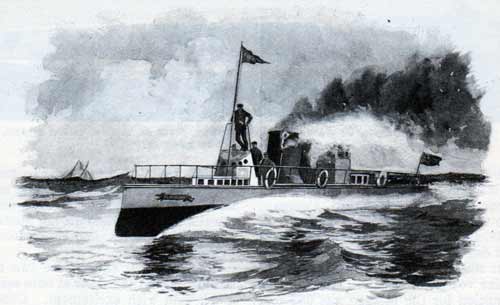The Great Western Steamship, 1837
The first steam vessel designed and built for the Atlantic trade was the Great Western, launched at Bristol, England, on July 19, 1837. In every particular, her building was a great departure from conventional ideas, and a decided contradiction to the prevailing authorities on marine architecture. These authorities had set forth that the best type for the coming ocean steamship should be a craft of about eight hundred tons, with engines of about two hundred horsepower.
But the Great Western was as much as two hundred and twelve feet long, and had a gross tonnage of 1,340. Her engines were of four hundred horsepower, with seventy-three inch cylinders and seven feet stroke. She was designed and built by William Patterson, of Bristol, for the Great Western Steamship Company. She arrived at New York on April 23, 1838, after a passage of fifteen days. Her best day's run was 243 knots; her average runs 208, and the hourly average for the entire voyage 8.2 knots. Her coal consumption for the passage was 655 tons.

The Turbinia, a British boat in which the turbine was first successfully substituted for the ordinary marine engine.
Just about the time when the Great Western passed the Hook, there also arrived the steamship Sirius. She was a much smaller craft, a hundred and seventy eight feet long; her tonnage was seven hundred and three, and her engines were of three hundred and twenty horse power. She had made the passage between Cork and the Hook in eighteen and a half days, and it had been a perilous trip that found her, near its ending, many miles off shore with a gale raging and her bunkers empty. As a desperate resort, she burned all her spars and most of her stores, and thus succeeded in making port.
The fact that there were two ocean steamships in the harbor at once set New York wild with excitement. Concern ing the event, the Courier and Enquirer of April 24, 1838, said editorially :
What may be the ultimate fate of this excitement—whether or not the expenses of equipment and fuel will admit of the employment of these vessels in the ordinary packet service—we cannot pretend to form an opinion; but of the entire feasibility of the passage of the Atlantic by steam, as far as regards safety, comfort and despatch, even in the roughest and most boisterous weather, the most skeptical must now cease to doubt.

The torpedo boat Stiletto, 31 tons, 359 horsepower, built at Bristol, Rhode Island, 1888, and famous for speed in her day.

One of the fastest boats on the Hudson was “The Vamoose” now owned as a yacht by Howard Gould.

The torpedo boat Cushing, 105 tons, 1,720 horsepower, built at Bristol, Rhode Island, 1889. Photograph by Loeffler, Tompkinsville.
No doubt the author of that paragraph esteemed himself a bold man to set down a conviction so daring.
For nine summers, the Great Western ran regularly between Bristol and New York, and was later sold to the Royal Mail Company for the West Indies service. The Sirius, after her first venture, did not attempt another voyage, but later in the year, a second Royal William entered the trade. She belonged to the City of Dublin Steam Packet Company, and was of almost exactly the same size as her Canadian namesake; but her speed was disappointing. Another steamboat of the same date, the Liverpool, owned by the Liverpool Transatlantic Steam Company, was likewise a failure from that standpoint.
The Story of the Steamship - Contents
Ocean Travel Steamship Voyages
GG Archives
Transatlantic Ships and Voyages
- 1870 The Ocean Steamer
- 1877Steamship Lines - Transatlantic Passenger Traffic
- 1885 The Influence of Sea Voyages Upon Women
- 1897 Twelve Days on A German Steamship
- 1899 On The Ocean: From the "Yiddish" Poem of M. Rosenfeld
- 1899 The Therapeutic Value of Ocean Voyages
1886 Development of the Steamship
Ocean Passenger Travel (1891)
Ocean Steamships (1882)
1901 Story of the Steamship (1901)
- Gambling on Ocean Liners (1890)
- Crossing the Atlantic Like A Seasoned Ocean Voyager (1904)
- The Ethics of Ocean Travel (1904)
- Who's Who On Board - The Secrets in the Passenger List (1910)
- Early Days of Trans-Atlantic Navigation (1912)
- Wreck of the RMS Titanic - First Account (1912)
- How to Get To Australia (1918)
- Passengers Travelling Abroad Fewer in Number This Season than In 1920 (1921)
- Giant Ex-German Liners Weapons in Duel of I.M.M. and Cunard for Blue Ribbon of Atlantic (1921)
- Reclassification of Older Passenger Ships in Transatlantic Trade Coming (1922)
The Dry Years - The Eighteenth Admendment
Ocean Travel Topics A-Z
- Boutique Shops & Ship's Stores
- Ocean Travel Books
- Brochures - Steamships & Ocean Liners
- Correspondence, Shipboard
- Fleet Lists of Passenger Ships
- Ships and Ocean Liners Archival Collections
- Interesting Fun Facts and Factoids
- Journeys in Steerage
- Ocean Journeys
- Other Ephemera
- Passage Contracts and Tickets
- Postcards of Steamships & Ocean Liners
- Programs and Concerts
- Provisioning Ocean Liners
- Sanitation at Sea
- Ship Passenger Lists
- Ship Publications
- Shipboard Affairs
- Steamship Captains
- Steamship Crew
- Steamship Lines
- Ship Tonnage and Measurements
- Steamship Port of Calls
- Stowaways Onboard
- RMS Titanic
- Transatlantic Voyages
- Travel Guide (1910)
- Vintage Advertisements
- Vintage Ocean Liner Menus
